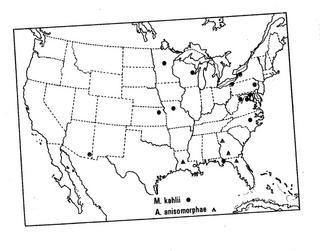
R. M. Bohart and L. S. Kimsey, 1982 · 9
Adelphe anisomorphae |
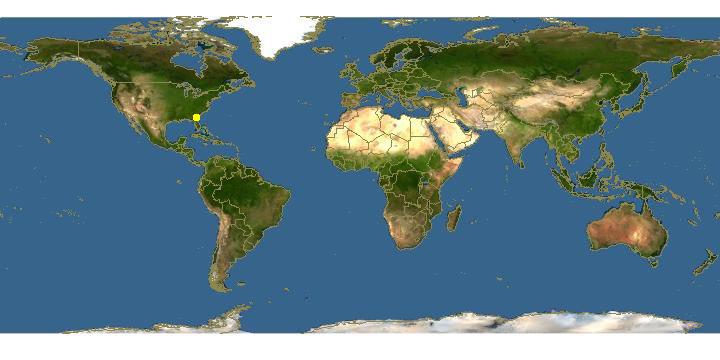
Click on map for details about points.
|
80x5 -
240x3 -
240x4 -
320x1 -
320x2 -
320x3 -
640x1 -
640x2
Set display option above.
Click on
images to enlarge. |
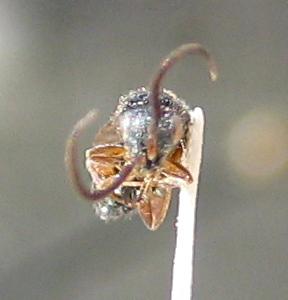
Native Bee Inventory and Monitoring Lab; Photographer: Erika Tucker · 1
Adelphe anisomorphae, face |
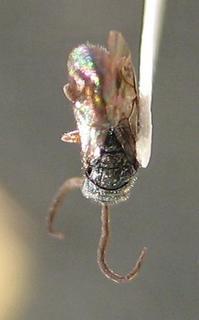
Native Bee Inventory and Monitoring Lab; Photographer: Erika Tucker · 1
Adelphe anisomorphae, top view |
|
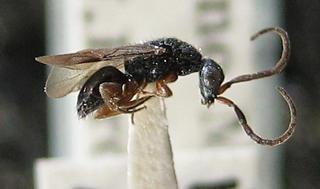
Native Bee Inventory and Monitoring Lab; Photographer: Erika Tucker · 1
Adelphe anisomorphae |
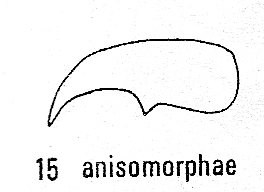
R. M. Bohart and L. S. Kimsey · 1
Adelphe anisomorphae, claw |
|
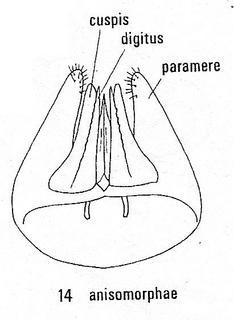
R. M. Bohart and L. S. Kimsey · 1
Adelphe anisomorphae, male genitalia |
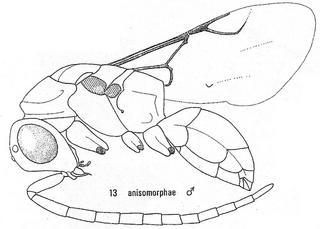
R. M. Bohart and L. S. Kimsey · 1
Adelphe anisomorphae |
|
Overview |
Taken from:
R. M. Bohart and L. S. Kimsey. 1982. A Synopsis of the Chrysididae in America North of Mexico.
Adelphe anisomorphae Krombein
(Figs. 13, 14, 15)
Adelphe anisomorphae Krombein 1060:35. Holotype male, Stone Mountain, De Kalb Co., Georgia (USN1vI).
Discussion: These are small, dark wasps ranging in length from 3.0 to 4.0 mm. The only species of Adelphe found north of Mexico, anisomorphae can be distinguished from the Mexican species, mexicana Mocsary, by the dark bronzy color of the head and thorax, the scape as Long as F-I which is Longer than F-II (fig. 13), and the propodeum less heavily ridged and sculptured. Genitalia are shown in fig. 14.
Host: Anisomorpha ferruginea (Beauvois) eggs. Krombein (1960) gave a detailed account of the parasitic behavior of anisomorphae. The female gnaws a hole in the host egg and then inserts her ovipositor through the hole to deposit an egg within.
Material examined: 2 males and 1 female.
Distribution: GEORGIA: De Kalb County (Stone Mt., Tifton); FLORIDA: Alachua County (Gainesville); LOUISIANA: Alexandria. Collection dates are August through September.
Adelphe Mocsary
Adelphe Mocsary 1890:46. Generotype: Adelphe mexicana Mocsary 1890, monotypic and designated by Ashmead 1902.
Pseudepryis Ducke 1902:204. Generotype: Pseudepryis paradoxa Ducke 1902, monotypic.
Adelpha Schulz 1906:163. Proposed unnecessarily. Nec Hübner 1819.
Parachrysis Kieffer 1910:287. Generotype: Parachrysis metallica Kieffer 1910. Nec Gribodo 1879.
Diagnosis: Pronotum with transverse groove, pronotal lobe touching tegula, midcoxae narrowly separated; male mandibles large, flattened and foliaceous; propodeal teeth well developed and digitate.
Discussion: Historically Adelphe was considered to be the nominal genus in the Adelphinae. Until and including Krombein’s major work on the Amiseginae (1960) this group was treated as a distinct subfamily, which also included Nesogyne, a South American group. However, more recently Krombein (pers. comm.) has reevaluated this group and considers Adelphinae to be synonymous with Amiseginae. These wasps are also parasites of phasmatid eggs. There is only one species of Adelphe found north of Mexico.
|
|
| Supported by | |
Updated: 2024-04-28 13:53:30 gmt
|